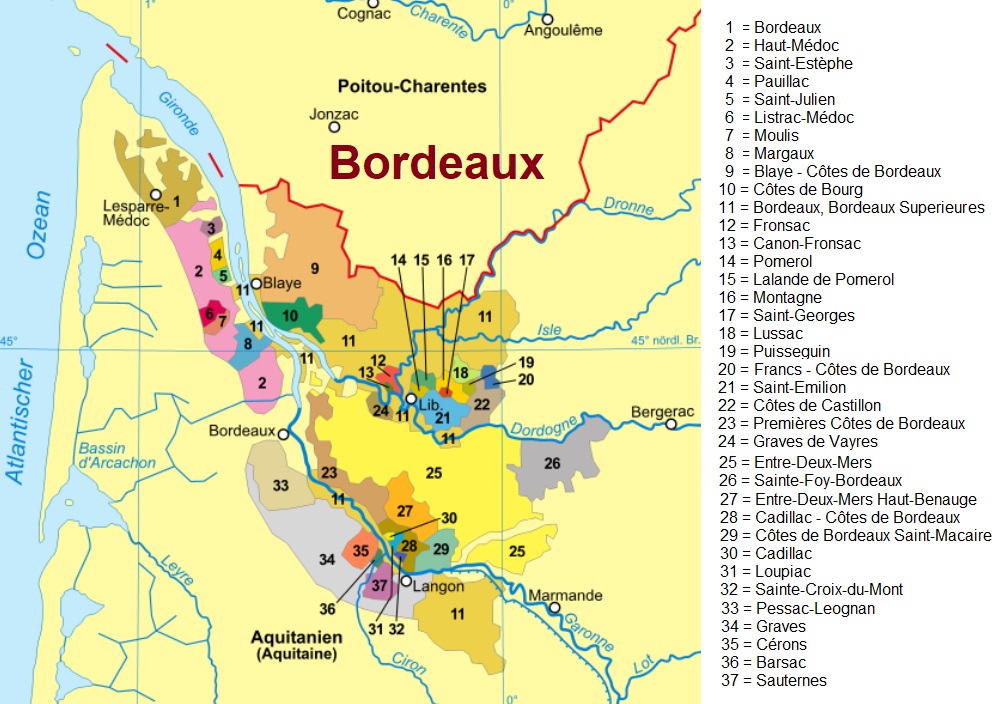Results
2,284 Results
Loading more Results ...
Loading more Results ...
| Sauternes AOC |
Description to Sauternes AOC
The appellation named after the commune of the same name with around 1,700 hectares of vineyards forms an island in the large Graves area in southern Bordeaux. It consists of the five communes of Bommes, Fargues-de-Langon, Preignac and Sauternes, as well as the right to its own appellation Barsac with 600 hectares. All Barsac wines may also use the name Sauternes or Sauternes-Barsac, but this does not apply vice versa. For centuries, mainly sweet white wines have been produced here from botrytised grapes. The later US President Thomas Jefferson (1743-1826), who was envoy to Paris from 1785 to 1789 and visited many French wine-growing regions during this time, described Sauternes as the best white wine in the country after Champagne and Hermitage. His ranking was also used as one of the criteria for the 1855 Sauternes classification (see below).

Sauternes appellation
The highly calcareous soil provides excellent conditions for white wines; red wines are less important. The appellation only applies to noble sweet white wines. Dry white wines may only use the AOC Bordeaux, red wines only the AOC Bordeaux or Bordeaux Supérieur. The appellation regulations for sweet white wines require an alcohol content of at least 13% by volume and proof of the required degree of sweetness through a sensory taste test. The yield limit is 25 hectolitres per hectare. The most common and most important white wine variety is Sémillon, which occupies around 80% of the total vineyard area at most wineries. The remaining white wine varieties are Sauvignon Blanc and Sauvignon Gris and some Muscadelle. The most common red wine varieties are Cabernet Sauvignon, Merlot, Cabernet Franc, Petit Verdot and Malbec (Cot). These are the typical grape varieties of the so-called Rive gauche (left bank).
The botrytis required for the noble sweet wines is favoured by the low altitude and the proximity to two rivers. When the cold waters of the Ciron flow into the warmer Garonne, fog forms in the depression and the interaction of cool, damp air and warmth from the sun creates ideal conditions. Noble sweet berries are used throughout. The glowing golden-coloured wine has a green shimmer. The bouquet is characterised by a rich aroma of apricots, honey and nuts. The full flavour is intense and sweet, but the sweetness is not overpowering due to the high alcohol content. The wines are usually matured in barriques. The white wines from Barsac are considered to be less full-bodied but more racy.
Bordeaux classification 1855
A classification for white wines was created for Sauternes and the neighbouring communes as part of the Bordeaux classification in 1855, just as for the Médoc area. In Sauternes, this was done in three classes. The Château d'Yquem was the only one in Bordeaux to receive the exclusive classification "Premier Cru Classé Supérieur", which was even higher than the red wines in the Médoc. Since then, there have been several changes to the vineyards due to changes of ownership and name. However, the classification is still valid and largely consistent, but has no significance in wine law:
Premier Cru Classé Supérieur (1)
- Château d'Yquem (Sauternes)
Premiere Cru Classé (11)
- Château Climens (Barsac)
- Château Clos Haut-Peyraguey (Bommes)
- Château Coutet (Barsac)
- Château Guiraud (Sauternes)
- Château Lafaurie-Peyraguey (Bommes)
- Château La Tour Blanche (Bommes)
- Château Rabaud-Promis (Bommes)
- Château de Rayne-Vigneau (Bommes)
- Château Rieussec (Fargues)
- Château Sigalas-Rabaud (Bommes)
- Château Suduiraut (Preignac)
Deuxième Cru Classé (15)
- Château d'Arche (Sauternes)
- Château Broustet (Barsac)
- Château Caillou (Barsac)
- Château Doisy-Daëne (Barsac)
- Château Doisy-Dubroca (Barsac)
- Château Doisy-Védrines (Barsac)
- Château Filhot (Sauternes)
- Château Lamothe Despujols (Sauternes)
- Château Lamothe Guignard (Sauternes)
- Château de Malle (Preignac)
- Château de Myrat (Barsac)
- Château Nairac (Barsac)
- Château Romer (Fargues)
- Château Romer-du-Hayot (Fargues)
- Château Suau (Barsac)
further information
In France, there is a bewildering variety of classification systems for wines, vineyards and appellations. This is even the case within one region, especially in Bordeaux. In addition to Sauternes, there are those of Graves, Médoc and Saint-Émilion. There is a consistent system in Burgundy. See also under Grand Cru and quality system.
Map: by Domenico-de-ga from Wikipedia, CC BY-SA 3.0, Link
modified by Norbert Tischelmayer 2017
Recent wines 14
The most important grape varieties
More information in the magazine
- Good Bordeaux doesn't have to be expensive! Crus Bourgeois
- Liv-ex Power 100: Bordeaux The number of brands in the top 100 has fallen to a new low
- Château Léoville Barton Saint Julien, 1997 Bordeaux, France
- Château Latour à Pomerol Latour à Pomerol 1981, Pomerol, Bordeaux, France
- Château Pichon Longueville Baron Les Tourelles de Longueville 1996, Pauillac, Bordeaux, France
- Château Beychevelle Beychevelle 2000, Saint Julien, Bordeaux, France
- Châteaux Ausone Ausone 1997, Saint-Emilion Grand Cru, Bordeaux
- Château Léoville Poyferré Saint Julien, 1997, Bordeaux
- Château de Monbousquet Angélique de Monbousquet 2008, Saint Emilion, Bordeaux
- Château Laujac Laujac 1996, Cru Bourgeois, Médoc, Bordeaux, France


